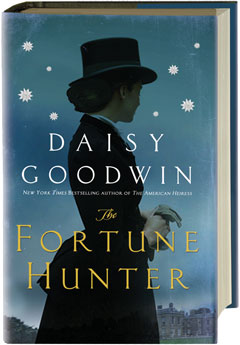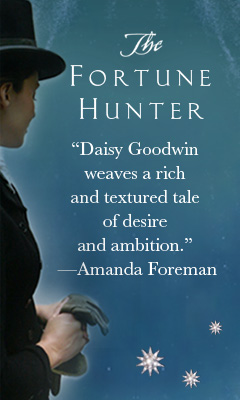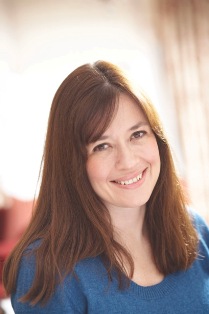The Fortune Hunter
by Daisy Goodwin
At the heart of Daisy Goodwin's The Fortune Hunter is a passionate love triangle that plays out in the ballrooms and on the hunting fields of Victorian England. As with her first novel, The American Heiress, which is based on the life of wealthy American Cora Cash, who married into the British aristocracy, this intriguing story was inspired by an actual figure: the Empress Elizabeth ("Sisi") of Austria. Goodwin describes the empress in her author's note as the Princess Diana of 19th-century Europe--famously beautiful and unfulfilled in her marriage to an older royal.
Readers have to wait a bit before meeting the Austrian monarch. Goodwin opens The Fortune Hunter with the other central female character in the story, Charlotte Baird, who might well be the only woman in London who dreads having a full dance card. Instead of being forced to make small talk with bumbling suitors enticed by the fortune to which she's the sole heir, she would rather be taking photographs. Mentioning her unusual pursuit--a cutting-edge development at the time--is usually a conversation stopper and ensures she isn't asked to dance a second time.
Twenty-year-old Charlotte knows she can't avoid marriage forever, but none of the men she meets holds her interest... until Bay Middleton. Undeniably handsome, the dashing cavalry captain is also witty, easygoing, kind and intrigued by a woman who would rather stand behind a camera than have a dress made.
But in this gilded world, which Goodwin re-creates in glittering detail, marriage is less about matters of the heart and more about advancing one's social status. Charlotte's imperious half-brother and guardian, Fred, and his ambitious fiancée, Augusta, warn her away from Bay, declaring him to be a ladies' man and a fortune hunter. Even worse than Bay's reputation for dallying with married women is that he's untitled and of modest means.
Just as Charlotte and Bay's secret relationship escalates from flirtation into something more serious, the empress enters the picture. Bay is widely acknowledged as the best rider in England, and his commanding officer assigns him to act as Sisi's pilot. His task is to guide her across the English countryside and through the protocols of one of the most prestigious and challenging fox hunts.
Attractive and athletic, intelligent and adventurous, 38-year-old Sisi seems to have everything. In truth, she is desperately lonely--at age 15 she married the Emperor Franz Joseph, a man with little time for anything other than presiding over his kingdom--and despairing over the toll age is taking on the beauty that has been "her weapon and her power."
Having escaped the stifling formality of the Austrian court and desperate to outrun her anxieties, Sisi arrives in England eager for the excitement of the hunt. Despite Bay's reluctance at being tasked as a "royal nursemaid," he quickly warms to Sisi, impressed by her riding skills and her fearlessness in leading the pack with him during the hunt. Plus, he's far from immune to her lauded looks.
The Fortune Hunter unfolds from the alternating perspectives of Charlotte, Bay and Sisi, allowing readers to get to know each character intimately--their hopes, fears, desires and driving factors. The story's strength is its portrayal of two vastly different yet strong, remarkable women. While Sisi is bound to a life of duty, the orphaned Charlotte's inheritance allows her a certain amount of control over her own life and the freedom and means to pursue photography. While Sisi's celebrated visage sells everything from chocolates to liver salts in Vienna, Charlotte is constantly reminded that hers is "not a face to launch a thousand ships." The empress crashes a wedding to size up Charlotte and leaves satisfied that someone so plain-looking couldn't possibly be a rival for Bay's attention.
The empress cuts an imposing figure across the pages of The Fortune Hunter, but it's quirky, spirited Charlotte who steals the story. When we first meet her she's pondering whether Queen Victoria should be a kitten or a cod fish as she alters a photo of the British royal family, superimposing images of animal heads onto the faces of the monarch and her clan.
Photography is an integral aspect of the storyline. Charlotte's passion for the pastime illuminates her unconventional character. Toting around camera equipment and having silver nitrate-stained hands from developing plates is considered "deuced odd," Fred tells her, and might give her a reputation.
The photography theme also compels the plot forward at several pivotal points. Goodwin does a terrific job conveying the impact of this strange, powerful new medium and its effect on people seeing fixed images of themselves for the first time. As Bay finds out, what is reflected back sometimes reveals truths you'd rather keep private. When the hunting party gathers one morning before setting out on the chase, Charlotte takes a candid shot of the empress and Bay off in the distance. After developing the photo, she sees him gazing at the monarch with obvious adoration and lust.
Charlotte doesn't wait around while Bay equivocates between wooing her and spending time with the empress (with whom he hunts by day and begins secretly trysting with by night). She heads for London to help her godmother, a photographer and her mentor, prepare entries for a prestigious photographic exhibit that will be attended by Queen Victoria, and then makes plans to journey to America.
Goodwin keeps the romantic tension taut until the very end, when Bay--who genuinely cares for both women--ultimately must decide where his heart lies. Will he publicly declare his allegiance to the empress, at her urging? Or, thanks to a twist of fate, will he grasp a second chance to reunite with Charlotte, if she hasn't yet sailed beyond his reach?
In The Fortune Hunter, Goodwin vividly evokes the atmosphere of the era while illuminating the universal sentiments of love, desire, purpose and ambition. Swiftly plotted, peopled with interesting, sympathetic characters and laced with humor and clever dialogue, this lively novel is historical fiction at its entertaining best. --Shannon McKenna Schmidt
Listen to a clip from the audio of The Fortune Hunter, narrated by Clare Corbett (ISBN 9781427236111, $39.99, 12 CDs, 14 hours), here.








